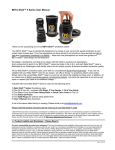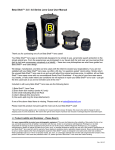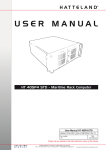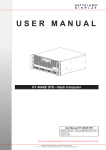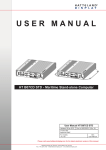Download User`s Manual - BETA Shell™ Series 3.0 /4.0
Transcript
Beta Shell™ 3.0 / 4.0 Series Case User Manual Thank you for purchasing one of our Beta Shell™ cases! Your Beta Shell™ lens case is intentionally designed to be simple to use, yet provide superb protection to the stored optical lens. From the experiences we have earned in our travels we have learned that light is right and unnecessary complexity is a liability – these two core philosophies are what have guided our Beta Shell™ lens case design and development. We design, manufacture, and test all our lens cases with the intent to exceed your expectations. Every component of our Beta Shell™ cases are made in the U.S.A. and each Beta Shell™ case is fabricated at our Washington state facility where we can closely monitor & demand excellent production quality. All our Beta Shell™ lens cases come with our unconditional Bomb-Proof Guarantee - If you are not satisfied with your Beta Shell™ lens case for any reason, we offer a 30 day “no questions asked” return policy. Simply return the unused Beta Shell™ lens case to us and we will refund the original purchase price. In addition, all our lens cases have a lifetime guarantee against manufacturing defects. Just send the case back to us and we will repair or replace your case at no additional charge. * Included with every Beta Shell™ lens case are the following items: 1) Beta Shell™ Lens Case 2) Foam Fitting Disk(s) (series 4.0 only) 3) One Indicating Silica Gel Pack 4) Two split rings (for optional strap attachment) 5) User’s Manual (this document) If one of the above listed items is missing. Please email us at [email protected] Please read this product manual to get the most out of your Beta Shell™ case! * Bomb-Proof Guarantee is honored by manufacturer to individual U.S. based customers. For international customers our Bomb-Proof Guarantee may or may not be honored by respective Beta Shell distributors. We reserve the right to charge for return shipping costs in some situatutions. We reserve the right to ask for payment for repairs if product was misused or damaged beyond reasonable repair. Please visit the Warranty section of our website @ http://www.betashell.com/Terms.asp to learn more. Product Liability and Disclaimer – Please Read It is your responsibility to protect your photographic equipment. The user shall determine the suitability of this product prior for his or her use, and shall assume all risk of liability in connection with that use. Under no circumstance will Mogomoto Prototype LLC be held responsible for damage to photo equipment arising from the use of this product. Neither Mogomoto Prototype LLC, it’s suppliers, subcontractors, dealers or agents are liable for any loss, injury, or damage whatsoever arising from the use of this product. Modifications to your Beta Shell™ lens case will void the warranty. Never expose to excessive heat or petroleum based solvents. Never use this lens case to carry or protect objects other than photographic equipment. Beta Shell™ cases are designed to be water-proof under test conditions. Water penetration will occur if lid is not properly closed, set, worn, or is damaged. Normal wear and tear will compromise the function of this product. Beta Shell™ lens cases are protected under U.S. patent right laws. Beta Shell™ lens cases are Patent Pending. Rev. 0711-5 1. Setting up a Beta Shell™ Case To open the case simply rotate the Top Lid in the counter-clockwise direction – just as you would open a water bottle. Note the icons on the lid indicating the rotational directions to open and close your lens case. For a secure seal there is no need to over-tighten the lid closed. For a water-proof seal please read section 2 below. Place your SLR or rangefinder interchangeable lens into the lens case. The front of the lens (lens cap end) should be rested against the foam found at the bottom of the case. The back end of the interchangeable lens (mounting end) should point up and have a storage end cap. The back end cap should not extend beyond the plane of the top surface of the open lens case (Fig. 1). If back of lens extends past the rim of case without the use of Foam Fitting Disks we recommend using a larger Beta Shell™ lens case size. An ideal fit is achieved when the lens end cap is 10 – 25mm (.5 – 1.0 inch) below the top surface of the open lens case. Fig. 1 – Checking the fit of lens inside Beta Shell™ case. If the end cap of your lens is more than 25mm below the top surface of the open lens case, then… Use the supplied 99mm or 77mm Foam Fitting Disks (white in color) to achieve the correct fit to an individual lens. When using the Foam Fitting Disk(s) to create a tighter fit, carefully remove the Lower Memory Foam at the bottom of the lens case – the Lower Memory Foam is not attached to the case and should pull right out. You should now see the plastic bottom of the lens case. Place the Foam Fitting Disk(s) at the bottom of the case, and then replace the Lower Memory Foam such that it sits on top Foam Fitting Disk(s). Re-insert the lens and check fit again as described above in figure 1. If the end cap of your lens is still more than 25mm below the top surface of the open lens case even with the use of Foam Fitting Disks, then… Use additional Foam Fitting Disks (available on our website), or order the next shorter length of Beta Shell™ case. As long as the correct fit is achieved using Foam Fitting Disks, a smaller lens can be adequately stored in an oversized Beta Shell™ case. With the use of Foam Fitting Disks a user can achieve the correct fit for multiple lenses using the same Beta Shell™ case. Many user choose to carry a single large case that can be adjusted with the use of the Foam Fitting Disks to accommodate swapping back and forth between a smaller or larger lens. If the end cap of your lens extends past the top surface of the open lens case without the use of Foam Fitting Disks, then… We suggest you order the next larger size of Beta Shell™ case. Now, with the correct fit achieved… To close your lens case, gently press the lens down to “set” its location – then immediately gather the lens end cap with the memory foam attached to the Top Lid assembly. The lens end cap should be aligned to the center of the Top Lid assembly foam. Press the Top Lid assembly down to compress the foam and simultaneously rotate the Top Lid in the clock-wise direction to close the case. The Top Lid should close with relative ease, as rotating the lid closed will compress the internal memory foam and lock the lens into place Refer to figure 2 on next page. Rev. 0711-5 Figure 2: Align to lens end cap to center of Lid foam and press-down to compress foam. To check the lens is properly secured in the lens case, gently wiggle the lens case. You should not feel the lens move significantly inside the case. If you can feel the lens move around significantly inside the lens case, remove the lens from the case and use the Foam Fitting Disks to create a tighter fit. If it takes excessive force to close the Top Lid, or the Top Lid memory foam feels like it might be damaged from a overly tight fit, then remove a Foam Fitting Disk from the case to create looser fit. Note – Foam Fitting Disk can be carefully trimmed to a half thickness with a sharp blade to provide a precise fit. If you plan on using your Beta Shell™ lens case in environments where dramatic changes in ambient temperatures occur – we strongly recommend placing a moisture absorbing Silica Gel Pack at the bottom of your case. Silica gel is a simple material that will absorb moisture generated from condensation on your lens and case (additional silica gel packs can be purchased on our website). Please remember that all Silica Gel Packs become saturated over time and need to be replaced. Also, remember any moisture that enters your lens case (such as rain or snow) will remain inside a sealed Beta Shell™ lens case. User’s Tip - Keep unused gel packs in an air-sealed bag to extend the life of silica gel packs. 2. Ensuring a Water-Proof Seal The primary design goal of your Beta Shell™ lens case is to protect your lens from environmental conditions. Components of your Beta Shell™ are all designed to protect your lens. Ultimately - how well your Beta Shell™ keeps dust, dirt, moisture, and the cold away from you lens depends purely on how tightly the Top Lid is closed. To keep dirt, dust, and rain water out of you lens case, the Top Lid need only to be closed relatively gently. If a 100% water-proof seal is required the Top Lid must be closed tightly enough to compress the heavy-duty O-ring seal. In general, an average male user can close the Top Lid tightly enough by hand to create a waterproof seal. It is very unlikely anyone can close the Top Lid by hand too tightly enough to damage the lens case. To guarantee anyone can close the Top Lid tightly enough to create a water-proof seal have we integrated simple leverage points in our Top Lid design to allow anyone to guarantee a 100% water-proof seal. By using the straight edge of a tool or table to gain leverage, any one can easily close a Top Lid tightly or free a tightly closed Lid (Fig. 3). Please visit the videos section of our webpage for more details. Figure 3: Use a rigid straight edge such as the edge of a table to tightly close Lid. Rev. 0711-5 Before you head out into the field and demand a 100% water-proof seal – we strongly recommend you experiment closing and opening your Beta Shell™ in a manner such that a 100% water-proof seal in achieved. You can easily verify a water-proof seal by submerging your Beta Shell™ (without a lens) in a buck of water. If air bubbles escape between the O-ring seal and the matting flat surface, then the Top Lid needs to be closed more tightly! Note – tiny air bubbles may initially surface as air escapes from small features on the outside of the case – this does not mean the lens case is leaking. Look for larger bubbles escaping from the O-ring / sealing surface interface that do not stop within a minute of submersion. 3. The Bungee Case Strap and Optional Strap Attachment Our lens case design includes a simple strap to help the user securely handle the case out from a stuffed pack. Our simple bungee strap is intended to aid you in grabbing your Beta Shell™ when the conditions get slick such as in rain or snow. When not in use, the bungee strap can by stored around the base of the lens case body (Fig. 4). In addition, the Bungee Strap can easily be replaced or removed by the user. All our Beta Shell™ cases also come with Split Rings that can be mounted by the user to facilitate attaching an aftermarket shoulder strap to the case. An additional benefit of attaching a simple shoulder strap using the supplied Split Rings, is that the Top Lid becomes tethered to the case body and cannot easily be lost or misplaced. Figures 4: Optional strap attachment & Bungee strap. 4. Care and Maintenance Your Beta Shell™ lens case is design to be essentially maintenance free. There are only two things to do to keep your lens case functioning like new – 1) keep the inside clean, and 2) keep the O-ring Seal clean. Remember that any dirt, dust, or substance that gets inside your Beta Shell™ case can end up on or inside your lens! If moisture collects inside your case, leave it open to dry out. Also, keep your lens case closed when not in use in the field. To clean the outside of your lens case simply wipe off with a damp cloth and let dry. Never use solvents (such as gasoline or acetone) on any part of your lens case – ABS plastic and solvents do not mix well! To clean the internal foam gently wipe down the foam surfaces with a wet towel or mild soap. Natural yellowing of the memory foam over time is normal and this will not damage your lens. Remember, the lower foam disk can be removed while the lid foam and neoprene liner are not removable. All memory foam can be replaced if it is reglued to the ABS shell (email us for how to replace memory foam). Compressed air also works well to remove dust and dirt imbedded in the Neoprene liner or memory foam. Leave the lens case open and let the inside of your Beta Shell™ dry completely before restoring a lens inside. Finally, keep the surface of the O-ring Seal clean. Using the corner of a wet towel, gently wipe dirt and dust off the O-ring seal surface – remember this seal is what keeps water and dust out. Once a year, use a Q-Tip style cotton swab to apply a Teflon or Silicon based lubricant (such as bike chain lube) to the surface of the O-ring seal. If you plan to keep a lens stored inside a Beta Shell™ lens case for a long period make sure there is not any excessive moisture trapped inside the case and use a fresh Silica Gel Pack inside the lens case. This product manual is not intended to cover all your questions regarding our Beta Shell™ lens cases. We encourage product feedback, questions, and comments – just e-mail, call, or write to us. Happy shooting and good luck in your photo assignments! Copyright 2010-2011 - Mogomoto Prototype LLC Rev. 0711-5




